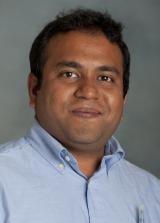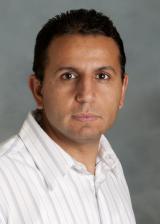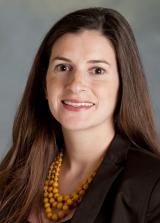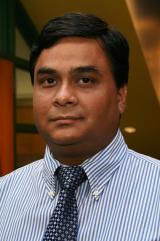 The study of blood flow, particularly in the brain, is typically the domain of biologists, physiologists, neuroscientists and physicians. But Vibhav Durgesh, assistant professor of mechanical engineering, has recast it as an engineering problem. His novel approach to blood flow inside brain aneurysms won him this year’s CECS faculty research fellowship, an annual award that allows a faculty member to spend a semester investigating an idea or pursuing a research project.
The study of blood flow, particularly in the brain, is typically the domain of biologists, physiologists, neuroscientists and physicians. But Vibhav Durgesh, assistant professor of mechanical engineering, has recast it as an engineering problem. His novel approach to blood flow inside brain aneurysms won him this year’s CECS faculty research fellowship, an annual award that allows a faculty member to spend a semester investigating an idea or pursuing a research project.
“The reason I’m studying this is that blood is a fluid, and I want to quantify the conditions leading to bursting in aneurysms,” he says.
An aneurysm is the abnormal ballooning or bulging of the wall of a weakened blood vessel, and it is estimated that 6 million Americans have an unruptured aneurysm. A ruptured aneurysm can be debilitating or fatal, yet corrective surgeries for the condition are high-risk operations.[Read more…]
Stumble |
Del.icio.us |
Reddit |
Facebook |
Digg |
Email
 When current passes through a wire, it creates a magnetic field, called direct electromagnetic coupling. The stronger the current, the stronger the magnetic field. But reduce things down to the nanoscale, and passing current through a wire won’t work as well—most of the current is lost to heat.
When current passes through a wire, it creates a magnetic field, called direct electromagnetic coupling. The stronger the current, the stronger the magnetic field. But reduce things down to the nanoscale, and passing current through a wire won’t work as well—most of the current is lost to heat.
With magnetic fields still needed at the nanoscale, researchers at the NSF-funded Center for Translational Applications for Nanoscale Multiferroic Systems (TANMS) found they could bypass the limitations of direct electromagnetic coupling by pairing a material that produces a magnetic field with one that creates an electrical field though mechanical strain, called “strain-mediated electromagnetic coupling.” A collaboration among CSUN, UCLA (where it is housed), UC Berkeley and Cornell University, as well as various research labs and industry partners from around the world, the center is using this technology to focus on three applications—nano motors, nano antennae and nano memory. (Multiferroic in the center’s name refers to composite materials consisting of piezoelectric and magnetostrictive materials.) [Read more…]
Stumble |
Del.icio.us |
Reddit |
Facebook |
Digg |
Email
 Whether you know it or not, embedded systems are everywhere in our environment, from the controllers in washing machines and on-board computers in cars to mobile phones and tablets, to name just a few examples. And now that they are becoming ubiquitous, the need is growing rapidly for professionals trained in the technology.
Whether you know it or not, embedded systems are everywhere in our environment, from the controllers in washing machines and on-board computers in cars to mobile phones and tablets, to name just a few examples. And now that they are becoming ubiquitous, the need is growing rapidly for professionals trained in the technology.
“There is data showing how many embedded processors are being sold versus general purpose processors, and the number is exponentially higher for embedded processors,” explains Ani Nahapetian, assistant professor of computer science. “It’s an area where there is growth commercially, but there will also be a need for trained students to work in that area.”
A recent grant from Intel Embedded will help CECS produce graduates with expertise in the field.[Read more…]
Stumble |
Del.icio.us |
Reddit |
Facebook |
Digg |
Email
 Over the past ten years, burst water and gas lines have been responsible for some $200 million in damage, and when they break, they are out of commission for a long time. Current techniques for inspecting pipes for damage—the very process that could minimize such accidents by identifying problems before they become manifest—require the shutdown of the entire distribution system for hours or even days, which is a costly proposition. It was recently estimated, for example, that shutting down the water distribution system in Arizona costs about $4 million an hour.
Over the past ten years, burst water and gas lines have been responsible for some $200 million in damage, and when they break, they are out of commission for a long time. Current techniques for inspecting pipes for damage—the very process that could minimize such accidents by identifying problems before they become manifest—require the shutdown of the entire distribution system for hours or even days, which is a costly proposition. It was recently estimated, for example, that shutting down the water distribution system in Arizona costs about $4 million an hour.
Non-destructive testing aims to develop techniques that can inspect the condition of critical pipelines and other infrastructure without hampering the delivery system. Rais Ahmad, an assistant professor of civil engineering and construction management and an expert in non-destructive testing, has recently embarked on a collaboration with Aerojet Rocketdyne’s non-destructive testing unit to develop a technique for finding defective pipes using guided acoustic waves. [Read more…]
Stumble |
Del.icio.us |
Reddit |
Facebook |
Digg |
Email
 The study of blood flow, particularly in the brain, is typically the domain of biologists, physiologists, neuroscientists and physicians. But Vibhav Durgesh, assistant professor of mechanical engineering, has recast it as an engineering problem. His novel approach to blood flow inside brain aneurysms won him this year’s CECS faculty research fellowship, an annual award that allows a faculty member to spend a semester investigating an idea or pursuing a research project.
The study of blood flow, particularly in the brain, is typically the domain of biologists, physiologists, neuroscientists and physicians. But Vibhav Durgesh, assistant professor of mechanical engineering, has recast it as an engineering problem. His novel approach to blood flow inside brain aneurysms won him this year’s CECS faculty research fellowship, an annual award that allows a faculty member to spend a semester investigating an idea or pursuing a research project. 


